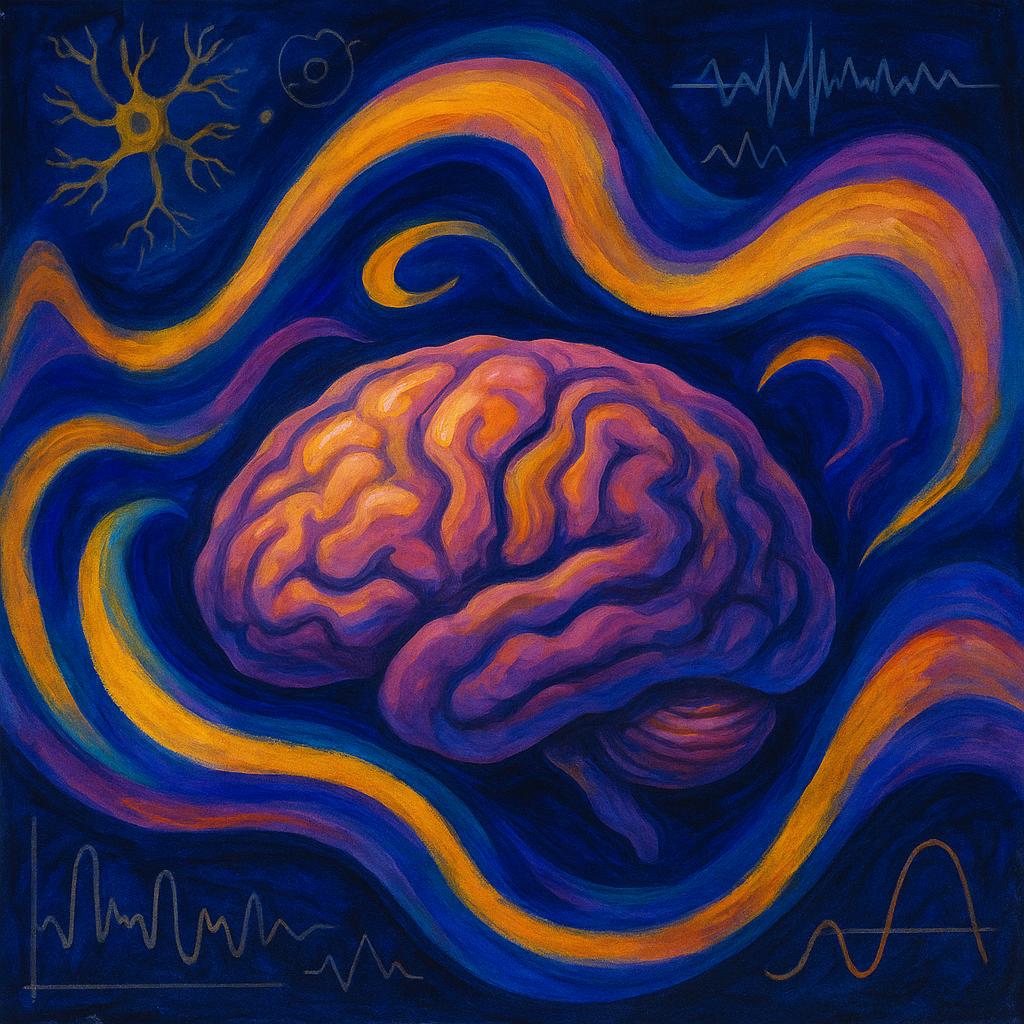The Delta state of the brain refers to a deep, restful phase of slow-wave sleep that typically occurs during the earliest and most profound cycles of the night. It is defined by the domination of slow, high-amplitude brain waves — called delta waves — which oscillate at a frequency of about 0.5 to 4 Hz. During this state, neuronal activity drops, allowing the body and mind to withdraw from external stimuli and enter a profoundly restful period.
The significance of Delta sleep for health and well-being cannot be overestimated. It plays a key role in physical recovery by triggering the release of growth hormones, strengthening the immune system, and reducing stress. Furthermore, it is during this deep state that memories become consolidated, synaptic connections are reorganized, and the brain effectively “resets” itself for a new day. Without enough deep, slow-wave sleep, both body and mind suffer, manifesting in poor memory, reduced ability to learn, a weak immune response, and an imbalance in stress regulation.
This essay is divided into several sections to provide a clear and comprehensive view of the Delta state. First, we will define its main characteristics and distinguish it from other phases of sleep. Next, we will explore its roles and mechanisms in physical and mental health. Subsequently, we will review methods used by researchers to measure and investigate deep sleep. Finally, we will consider disorders that undermine this state and potential strategies to help promote and protect it.
Definition and Characterization of the Delta State
The Delta state of the brain is a profoundly deep phase of slow-wave sleep that predominantly occurs during the earliest cycles of the night. It is defined by slow oscillatory brain activity, called delta waves, which emerge when neuronal activity becomes highly synchronized across large regions of the cerebral cortex. These slow waves typically range in frequency from about 0.5 to 4 Hz, reflecting a dramatic reduction in neuronal firing and synaptic activity. The amplitude of these waves is notably large, often exceeding 75 microvolts and sometimes extending well above 100 microvolts. This highlights the strong neuronal synchronization and unified behavior of neuronal assemblies during this state.
The duration of the Delta state varies from person to person and from one night to another, but it predominantly occurs during the first two non-REM cycles of the night, adding up to nearly 20% of total sleep in healthy adults. It typically dominates stage 3 of non-REM, sometimes called slow-wave sleep (SWS), and signals a period when the body enters its most restful and physiologically quiescent form of sleep. During this state, heart rate, blood pressure, and metabolic activity diminish, reflecting a deep relaxation and a temporary reduction in the body’s energy demands.
This slow-wave activity stands in contrast to other phases of sleep, particularly REM (Rapid Eye Movement), which is marked by fast, low-amplitude neuronal activity, vivid dreaming, and an increase in cerebral metabolic activity. While the Delta state involves reduced neuronal communication and a strong synchronization across large groups of neurons, the REM state is more desynchronized, reflecting the specialized neuronal processing associated with vivid dream content and memory consolidation mechanisms.
Furthermore, the Delta state is less reactive to external stimuli; the sleeper is less likely to be awakened by minor disturbances, reflecting a higher arousal threshold. It is this deep, slow-wave activity that provides the body and mind with an opportunity to repair, regenerate, consolidate memories, and reorganize neuronal circuits in preparation for wakefulness. The characterization of this state — its slow-frequency, large-amplitude waves, its reduced neuronal activity, and its resistance to external disturbances — underscores its unique role in human physiology and health.
Functions and Significance of Delta Sleep
Delta sleep plays a key role in the body’s ability to repair, regenerate, and consolidate its resources after a day of activity. It is a profoundly restful state in which physiological repair mechanisms become more active and efficient. During this deep, slow-wave phase, the body enters a state of reduced metabolic demand — the heart rate drops, breath becomes slow and regular, and muscle activity is at its lowest. Importantly, this slowdown provides a window for numerous repair and renewal processes to take place. Tissues and cells damaged by daily wear and stress are restored, growth hormones are secreted in greater amounts, and proteins necessary for repair and maintenance are manufactured at an accelerated rate. The release of growth factors during this period assists in strengthening and rebuilding muscles, bones, and the nervous system, adding a physical dimension to the benefits of deep sleep.
Furthermore, the significance of deep, slow-wave sleep extends well beyond physical renewal; it is a key period for consolidating memories and strengthening neuronal circuits. During this state, the hippocampus — a structure crucial for memory formation — communicates efficiently with the cerebral cortex to transfer newly formed memories into long-term storage. This process, called memory consolidation, depends on slow oscillations to act as a “timing signal” for neuronal activity, allowing related memories to be replayed and integrated into existing networks. The large, slow waves of the Delta state create a unique opportunity for the nervous system to reorganize its synaptic connections, strengthening those circuits that reflect valuable knowledge and weakening those that are less frequently used. Consequently, deep sleep directly contributes to enhanced learning, problem-solving, and creativity upon awakening.
In addition to its role in physical renewal and memory processing, deep, slow-wave sleep profoundly influences the body’s immune system and overall health. During this state, cytokine production and release — key components of the body’s immune response — are upregulated, strengthening the ability to combat viruses and other pathogens. Furthermore, the reduced stress physiology during deep sleep — lower adrenaline and norepinephrine, reduced activity of the HPA (hypothalamic-pituitary-adrenal) axis — assists in conserving energy and resources for protective mechanisms. Certain components of the adaptive immune response, such as the proliferation of T-cells and the release of protective cytokines, are particularly active during this period, reflecting a close link between deep sleep and robust immune health.
The influence of slow-wave sleep reaches into numerous other aspects of physiology, from metabolic regulation and glucose homeostasis to cardiovascular health and neurodegenerative disease resistance. There is growing recognition that deep, restful sleep assists in clearing metabolic waste products from the brain — a process facilitated by the glymphatic system — thereby reducing the accumulation of neurotoxic proteins, such as beta-amyloid and tau, which have been associated with disorders like Alzheimer’s disease. Furthermore, proper slow-wave activity supports balanced neuroendocrine signals, helping regulate stress responses and the release of key metabolic and growth-related hormones.
Together, these mechanisms underscore the central role of deep, slow-wave sleep in maintaining health and functionality across multiple systems. Without sufficient slow-wave sleep, the body’s ability to repair itself, consolidate memories, regulate stress, and fend off disease is profoundly compromised. Thus, understanding and protecting this stage of sleep is not simply a matter of rest; it is a prerequisite for physical renewal, cognitive stability, and overall well-being.
Measurement of Delta Activity.
Slow-wave (“delta”) sleep in humans is assessed via polysomnography (PSG), the clinical gold-standard in which scalp electroencephalography (EEG) is recorded alongside eye movements and muscle tone. On scalp EEG, delta waves appear as high-amplitude slow oscillations (generally ~0.5–4 Hz) arising from synchronous cortical firing. By convention, deep non-REM sleep (Stage N3, or slow-wave sleep) is scored when over 20% of a 30-second epoch contains delta-frequency waves of large amplitude. In fact, the AASM manual defines N3/SWS as epochs with ≥20% of their duration showing slow oscillations (roughly 0.5–2 Hz) exceeding ~75 μV in peak-to-peak amplitude. In practice, PSG EEG is filtered to isolate low frequencies, and technicians identify delta waves by both their frequency and voltage. Automated algorithms similarly quantify slow-wave activity (SWA) by computing spectral power in the delta band across EEG channels. In short, the combination of multi-channel EEG recording and standard scoring rules allows reliable detection and quantification of delta oscillations during human sleep.
Landmark Human Studies.
A number of key human experiments have revealed the functions of delta sleep. In one influential study, Marshall et al. (2006) applied oscillating transcranial currents (0.75 Hz) to enhance slow oscillations during early non-REM sleep. They found that induced slow waves significantly increased sleep-stage N3 and concomitantly improved next-day declarative memory retention compared to control stimulation. This landmark result supported a causal role for slow oscillations in human memory consolidation: boosting cortical delta activity during sleep led to better hippocampus-dependent memory. Complementing this, intracranial recordings in epilepsy patients have demonstrated that during SWS low-frequency (delta/infraslow) signals propagate from hippocampus to neocortex, reversing the direction seen in wake. This bidirectional “cortical–hippocampal dialogue” model (Mitra et al., 2016) provides direct evidence in humans that hippocampal memory traces are replayed through delta-band communication in slow-wave sleep.
The importance of delta sleep in cognition is further highlighted by aging studies. In a cohort of healthy adults, Mander et al. (2013) found that age-related atrophy of the medial prefrontal cortex was associated with markedly reduced NREM SWA and impaired overnight memory retention. In other words, older individuals with diminished frontal slow waves showed worse consolidation of episodic memories, suggesting that deterioration of delta sleep may contribute to cognitive decline with age. Similarly, sleep studies in Alzheimer’s disease have observed that patients spend less time in N3 and exhibit lower SWA overall; this reduced SWS correlates with their memory impairments. In particular, Lee et al. (2020) noted that Alzheimer’s subjects showed diminished non-REM SWA and argued that these slow-wave deficits might both reflect and exacerbate amyloid pathology and learning failures. Together, these human studies – spanning interventional, imaging, and clinical cohorts – link delta oscillations to memory processes and brain health, making them cornerstones of our understanding of slow-wave sleep.
Recent Findings and Open Questions.
Building on these insights, recent research has explored how modulating delta sleep might improve memory and brain health, especially in aging or disease. Noninvasive slow-wave enhancement has been a major focus: for example, auditory or electrical stimulation phase-locked to the intrinsic slow oscillation can strengthen SWA. In a recent trial, Wunderlin et al. (2023) applied multi-night phase-locked acoustic stimulation (PLAS) during SWS in older adults. They observed lasting increases in delta-band power and sleep spindle nesting, which were in turn associated with improved memory performance (even three months later) and favorable changes in plasma amyloidβ levels. These findings suggest that boosting human delta sleep can have durable cognitive benefits and potentially aid glymphatic clearance of metabolites – a promising avenue for dementia prevention.
At the same time, important questions remain about delta sleep. What are the precise circuit mechanisms by which slow waves sculpt memory? How do delta oscillations interact with other sleep rhythms (e.g. spindles, ripples) in the human brain? What causes the age-related decline in SWA, and can it be reversed? Clinically, investigations are examining whether disrupted SWS contributes to cognitive impairment in sleep disorders. For instance, narcolepsy is characterized by an almost complete absence of delta sleep (patients rapidly enter REM sleep), highlighting the role of hypocretin in maintaining N3 sleep. Obstructive sleep apnea and insomnia also fragment slow-wave sleep, and current studies are probing their effects on memory and neurodegeneration.
In summary, EEG and polysomnography provide the tools to identify delta waves in humans, and landmark studies (e.g. Marshall et al. 2006; Mitra et al. 2016; Mander et al. 2013) have firmly linked slow oscillations to memory and aging. Ongoing research is now targeting delta sleep as a modifiable neurophysiological process, with interventions (auditory, electrical, pharmacological) aimed at enhancing SWA to boost learning and possibly slow neurodegenerative pathology. This rich, human-centered literature continues to define the nature and functions of delta sleep with both basic and clinical implications.
Research Methods and Findings
Polysomnography (PSG) remains the clinical standard for assessing slow‑wave (“delta”) sleep in humans. In PSG, scalp electroencephalography (EEG) is recorded alongside electrooculography and electromyography to classify sleep stages according to the American Academy of Sleep Medicine (AASM) criteria (Iber et al. 2007). Delta waves appear on EEG as high‑amplitude oscillations in the 0.5–4 Hz band, frequently exceeding 75 µV in peak‑to‑peak voltage. Non‑REM Stage 3, or slow‑wave sleep (SWS), is scored when at least 20 % of a 30‑second epoch contains these slow oscillations (Iber et al. 2007). In addition to visual scoring, spectral analysis algorithms compute slow‑wave activity (SWA) by quantifying power in the delta band across multiple channels, yielding an objective measure of Delta sleep intensity.
In a landmark intervention, Marshall et al. (2006) applied transcranial alternating current stimulation at 0.75 Hz during early non‑REM sleep to enhance endogenous slow waves. Participants who received this stimulation showed increased SWS duration and demonstrated significantly improved retention of declarative memories the following morning compared to sham controls. This study provided causal evidence that augmenting cortical slow oscillations directly benefits hippocampus‑dependent memory consolidation.
Further insight into Delta‑wave propagation emerged from intracranial EEG recordings in epilepsy patients. Mitra et al. (2016) observed that during SWS, low‑frequency oscillatory activity flows from hippocampus to neocortex, reversing the information flow seen in wakefulness. This bidirectional “cortical‑hippocampal dialogue” supports the hypothesis that hippocampal memory traces are replayed and integrated into cortical networks under slow‑wave regulation.
Age‑related changes in SWA have been linked to cognitive decline. In a cohort of healthy older adults, Mander et al. (2013) reported that reduced medial prefrontal cortex volume correlated with declines in non‑REM SWA and poorer performance on overnight episodic memory tasks. Participants with the lowest frontal SWA showed the greatest deficits in memory retention, suggesting that loss of Delta sleep may underlie aspects of age‑related memory impairment.
Alzheimer’s disease further illustrates the clinical significance of Delta sleep. Lee et al. (2020) found that patients with Alzheimer’s dementia spent significantly less time in Stage 3 sleep and exhibited lower SWA than age‑matched controls. The reduction in slow‑wave power correlated with elevated cerebrospinal fluid amyloid‑β levels and with the severity of memory impairment. These findings imply that impaired Delta sleep may both reflect and exacerbate amyloid pathology by disrupting glymphatic clearance of neurotoxic proteins.
Recent human trials have explored whether enhancing Delta sleep can yield sustained benefits. Wunderlin et al. (2023) employed multi‑night phase‑locked acoustic stimulation, delivering brief auditory clicks timed to the up‑state of endogenous slow oscillations in older adults. This protocol produced lasting increases in SWA and spindle nesting, accompanied by improved memory performance that persisted at a three‑month follow‑up. Participants also demonstrated reduced plasma amyloid‑β concentrations, hinting at potential long‑term neuroprotective effects of noninvasive Delta enhancement.
Despite these advances, key questions remain. The precise thalamocortical circuits that generate and coordinate Delta oscillations in aging brains are not fully mapped. The interplay between slow waves and other sleep rhythms—such as sleep spindles and hippocampal ripples—requires further clarification at the cellular level. Pharmacological approaches to boost SWA without disrupting overall sleep architecture are in early stages of development but face challenges in specificity and safety. Clinically, the extent to which sleep disorders like obstructive sleep apnea and chronic insomnia impair Delta activity—and thereby accelerate cognitive decline—demands systematic investigation.
In summary, human sleep research employs EEG and PSG, combined with spectral analysis, to identify and quantify Delta‑wave activity. Pioneering studies by Marshall et al. (2006), Mitra et al. (2016), Mander et al. (2013), Lee et al. (2020), and Wunderlin et al. (2023) have demonstrated the functional importance of deep slow‑wave sleep for memory consolidation, healthy aging, and potential dementia prevention. Ongoing research aims to map underlying neural circuits, refine noninvasive enhancement techniques, and translate these findings into interventions for sleep‑related cognitive disorders.
Disorders of Delta Sleep and Their Consequences
Insomnia and obstructive sleep apnea are two prevalent sleep disorders that markedly reduce the duration and intensity of delta sleep. In primary insomnia, patients experience difficulty initiating or maintaining sleep, leading to fragmented non‑REM stages and shortened periods of slow‑wave sleep (Espie et al. 2008). Continuous micro‑arousals disrupt the emergence of high‑amplitude delta oscillations, decreasing slow‑wave activity (SWA) by up to 40 percent (Riemann et al. 2010). Obstructive sleep apnea (OSA) involves repetitive upper‑airway collapse, triggering brief arousals that terminate slow‑wave epochs prematurely (Punjabi 2008). Moderate to severe OSA patients may lose more than half of their delta sleep time, despite spending normal total time in bed.
A chronic deficit in delta sleep has far‑reaching health and cognitive repercussions. Physiologically, reduced SWA impairs secretion of growth hormone, attenuates immune function, and elevates inflammatory markers such as interleukin‑6 and C‑reactive protein (Irwin et al. 2016). Metabolic dysregulation follows: lower delta sleep correlates with insulin resistance and increased risk of type 2 diabetes (Tasali et al. 2008). Cardiovascular vulnerability also rises, as disrupted SWS is linked to hypertension and elevated resting heart rate (Trinder et al. 2003). Cognitively, delta sleep deprivation undermines declarative memory consolidation and executive function. Experimental suppression of slow waves yields performance deficits on verbal recall tasks equivalent to total sleep deprivation (Mander et al. 2017). Longitudinal studies show that adults with persistently low SWA are at higher risk of age‑related cognitive decline and dementia (Lim et al. 2013).
Various therapies target restoration of delta sleep. Continuous Positive Airway Pressure (CPAP) remains the standard for OSA: by eliminating apneas, CPAP users recover up to 80 percent of lost SWS within weeks (Weaver and Grunstein 2008). Cognitive Behavioral Therapy for Insomnia (CBT‑I) improves sleep continuity and gradually increases SWA by restructuring maladaptive beliefs and behaviors related to sleep (Trauer et al. 2015). Emerging non‑invasive brain stimulation techniques show promise: slow oscillatory transcranial direct current stimulation (so‑tDCS) at 0.75 Hz during early non‑REM sleep enhances SWA by 20–30 percent and improves overnight memory retention (Prehn‑Kristensen et al. 2014). Phase‑locked auditory stimulation, delivering brief pink noise clicks in synchrony with endogenous up‑states, can boost SWA and spindle coupling without arousals, leading to measurable gains in memory consolidation (Ngo et al. 2013). Pharmacological approaches, such as low‑dose gamma‑hydroxybutyrate (GHB), increase SWS, but carry a risk profile that limits widespread use (Mendelson and Gillin 1989).
In sum, insomnia and OSA severely curtail delta sleep, precipitating hormonal, immune, metabolic, cardiovascular, and cognitive impairments. Effective treatments—from CPAP and CBT‑I to targeted brain stimulation—can restore slow‑wave activity and mitigate downstream health risks, underscoring the centrality of delta sleep to holistic human function.
Conclusion
In summary, the Delta state is defined by synchronized slow waves (0.5–4 Hz) during non‑REM Stage 3 sleep. These waves drive physical repair through growth‑hormone release, support immune function via cytokine regulation, and enable memory consolidation by coordinating hippocampal‑cortical communication. Polysomnography and EEG quantify Delta‑wave frequency, amplitude, and duration. Landmark studies (Marshall et al. 2006; Mander et al. 2013; Lee et al. 2020) demonstrate that enhancing slow‑wave activity—whether by transcranial stimulation, acoustic phase‑locking, or behavioral therapy—restores SWS and improves cognitive and health outcomes.
Disorders such as insomnia and obstructive sleep apnea fragment Delta sleep, reducing growth‑hormone secretion, impairing glymphatic clearance of neurotoxic proteins, and undermining declarative memory. Effective treatments (CPAP, CBT‑I, tDCS, acoustic stimulation) recover up to 80 percent of lost SWS, lowering inflammatory markers and improving next‑day performance.
In daily life, maintaining regular bedtimes, minimizing evening blue‑light exposure, and managing stress bolster deep sleep. Shielding Delta sleep enhances alertness, mood stability, and disease resistance.
Future research must map thalamocortical circuits that generate slow oscillations, clarify interactions with spindles and ripples, and develop safe pharmacological agents to boost SWS without disrupting sleep architecture. Longitudinal trials in aging and dementia cohorts will assess whether targeted Delta enhancement can slow cognitive decline. Integrating individualized sleep profiling with tailored interventions offers a path to preserve deep sleep and sustain cognitive and physical health over a lifetime.
Literature Cited
- Iber, C., Ancoli‐Israel, S., Chesson, A. L. Jr., & Quan, S. F. (2007). The AASM Manual for the Scoring of Sleep and Associated Events: Rules, Terminology and Technical Specifications. Darien, IL: American Academy of Sleep Medicine.
- Marshall, L., Helgadóttir, H., Mölle, M., & Born, J. (2006). Boosting slow oscillations during sleep potentiates memory. Nature, 444(7119), 610–613.
- Mitra A, Snyder AZ, Hacker CD, Pahwa M, Tagliazucchi E, Laufs H, Leuthardt EC & Raichle ME (2016). Human cortical–hippocampal dialogue in wake and slow-wave sleep. Proceedings of the National Academy of Science of the U.S.A. 113(44): E6868–E6876.
- Mander B.A., Rao V., Lu B., Saletin J.M., Lindquist J.R., Ancoli-Israel S., Jagust W.J., Walker M.P. (2013). Prefrontal atrophy, disrupted NREM slow waves and impaired hippocampal‐dependent memory in aging. Nature Neuroscience, 16(3), 357–364.
- Lee, J.-H., Kim, Y.-S., Park, H., & Bae, G.-Y. (2020). Reduced slow‐wave sleep in Alzheimer’s disease correlates with cerebrospinal fluid amyloid‐β levels and memory impairment. Sleep, 43(9), zsaa045.
- Espie, C. A., Broomfield, N. M., MacMahon, K. M., Macphee, L. M., & Taylor, L. M. (2006). The attention–intention–effort pathway in psychophysiologic insomnia: A theoretical review. Sleep Medicine Reviews, 10(4), 215–245.
- Riemann, D., Spiegelhalder, K., Feige, B., Voderholzer, U., Berger, M., & Perlis, M. (2010). The hyperarousal model of insomnia: a review of the concept and its evidence. Sleep Medicine Reviews, 14(1), 19–31.
- Punjabi, N. M. (2008). The epidemiology of adult obstructive sleep apnea. Proceedings of the American Thoracic Society, 5(2), 136–143.
- Irwin, M. R., Olmstead, R., & Carroll, J. E. (2016). Sleep disturbance, sleep duration, and inflammation: A systematic review and meta‐analysis of cohort studies and experimental sleep deprivation. Biol. Psychiatry 2016 (vol. 80, issue 1).
- Tasali, E., Leproult, R., Ehrmann, D. A., & Van Cauter, E. (2008). Slow‐wave sleep and the risk of type 2 diabetes in humans. Proceedings of the National Academy of Sciences, 105(3), 1044–1049.
- Trinder, J., Welch, A., Cleator, M., & Kay, A. (2003). Cardiac modulation during sleep: The effect of sleep stage transitions and EEG arousals. Clinical Science, 105(4), 475–481.
- Mander, B. A., Winer, J. R., & Walker, M. P. (2017). Sleep and human aging. Neuron, 94(1), 19–36.
- Weaver, T. E., & Grunstein, R. R. (2008). Adherence to continuous positive airway pressure therapy: The challenge to effective treatment. Proceedings of the American Thoracic Society, 5(2), 173–178.
- Trauer, J. M., Qian, M. Y., Doyle, J. S., Rajaratnam, S. M., & Cunnington, D. (2015). Cognitive behavioral therapy for chronic insomnia: A systematic review and meta‐analysis. Annals of Internal Medicine, 163(3), 191–204.
- Prehn‐Kristensen, A., Munz, M., Molzow, I., Wilhelm, I., & Born, J. (2014). Transcranial oscillatory direct current stimulation during sleep improves declarative memory consolidation in children with ADHD. Brain Stimul. 2014 Nov-Dec;7(6):793–799..
- Ngo, H.-V. V., Martinetz, T., Born, J., & Mölle, M. (2013). Auditory closed‐loop stimulation of the sleep slow oscillation enhances memory. Neuron, 78(3), 545–553.
- Mendelson, W., & Gillin, J. C. (1989). Induction of slow‐wave sleep with gamma‐hydroxybutyrate. Sleep, 12(5), 539–546.
Further Reading
- Buzsáki, G. (2006). Rhythms of the Brain. Oxford University Press.
- Diekelmann, S., & Born, J. (2010). The memory function of sleep. Nature Reviews Neuroscience, 11(2), 114–126.
- Xie, L., et al. (2013). Sleep drives metabolite clearance from the adult brain. Science, 342(6156), 373–377.





